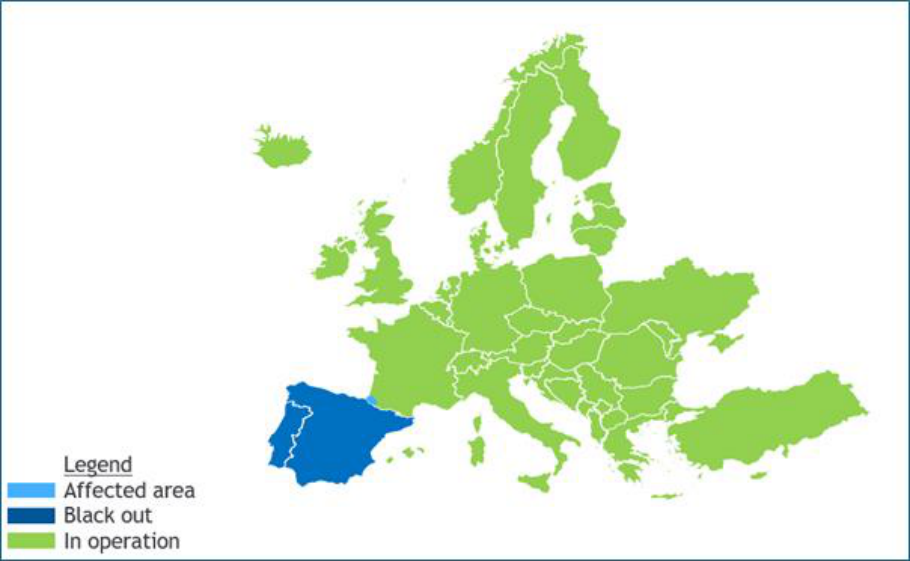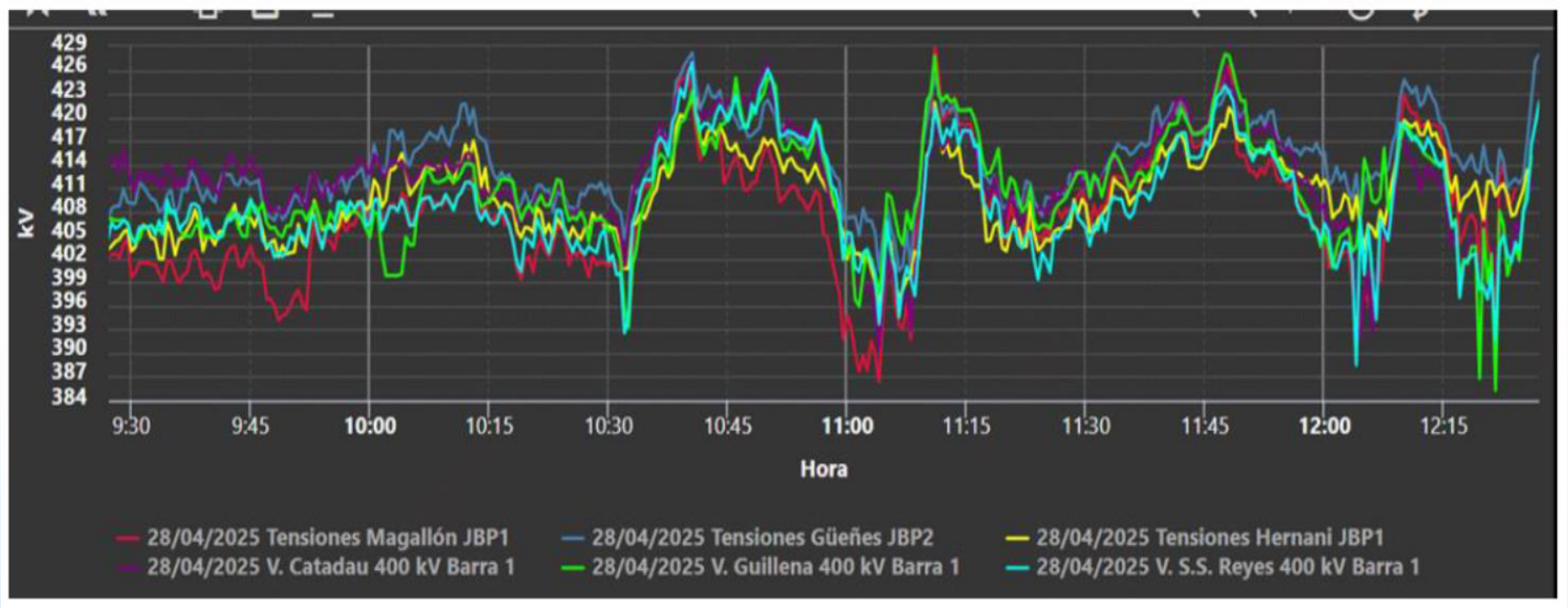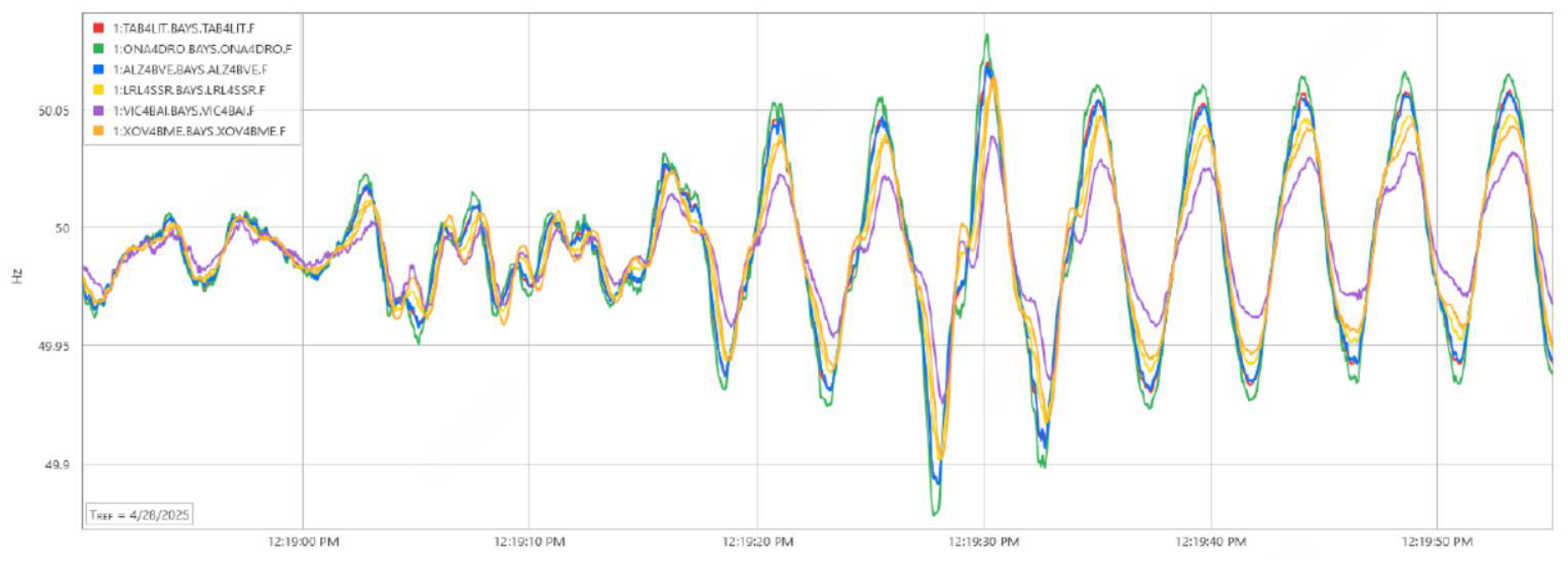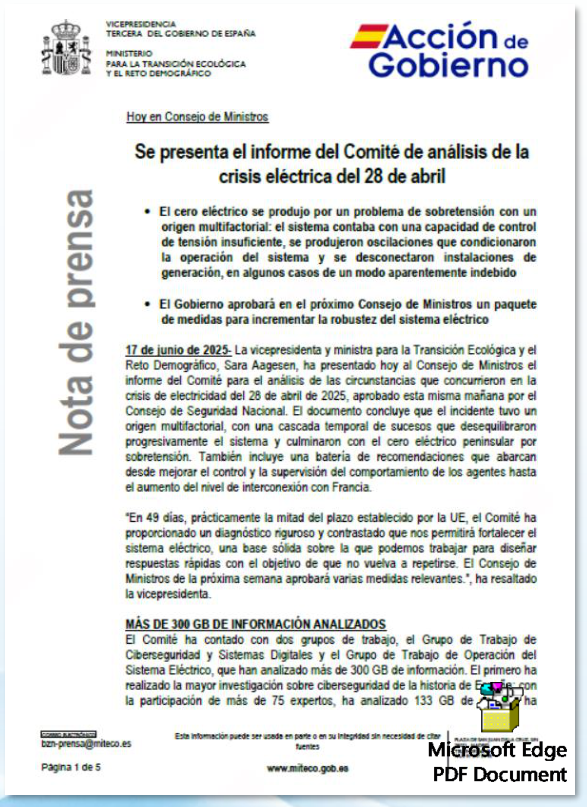Spanish Blackout Incident - Detailed Timeline
April 28th, 2025 | Iberian Peninsula Grid Collapse In-Depth Analysis
Incident Impact
Affected 35 million people | Economic losses exceeded €20 billion | Duration from hours to 3 days
Incident Affected Areas

Click to zoom
Phase I: System Oscillation Events
12:00 - 12:30
The grid experienced two severe oscillation events: 0.6Hz forced oscillation and 0.2Hz natural oscillation, with dramatic voltage fluctuations. REE control center implemented multiple emergency measures with limited effectiveness.
REE Official Report Overview

Click to zoom
12:00 - 12:03
System voltage and frequency were within normal operating range, with 0.2 Hz inter-area oscillation damping at 20%. System operation was stable.
400kV Transmission Network Voltage (00:00-09:00 on April 28th)

Click to zoom
400kV Transmission Network Voltage (09:30-12:30 on April 28th)

Click to zoom
12:03 - 12:07
0.6Hz Forced Oscillation Outbreak
• Duration: 4 minutes and 42 seconds
• 0.2Hz oscillation damping dropped sharply to 5%
• System-wide average voltage decreased by approximately 30kV (375-410kV)
• Spain-France interconnection power exchange showed synchronous oscillation
• Duration: 4 minutes and 42 seconds
• 0.2Hz oscillation damping dropped sharply to 5%
• System-wide average voltage decreased by approximately 30kV (375-410kV)
• Spain-France interconnection power exchange showed synchronous oscillation
REE Emergency Measures
- Coupled 400kV lines to reduce system impedance
- Reduced exports to France by 800MW, set export plan to 1,500MW
- Switched France DC link to constant power mode (1,000MW)
- Disconnected parallel reactors to alleviate low voltage
12:16
0.6Hz Oscillation Recurrence
Voltage fluctuations of 380-405kV occurred. Parallel reactors were disconnected again and previous stabilization measures were repeated.
Voltage fluctuations of 380-405kV occurred. Parallel reactors were disconnected again and previous stabilization measures were repeated.
Spain-France Power Exchange (12:06-12:08, 0.6 Hz Oscillation)

Click to zoom
Spain-France Power Exchange (12:02-12:08, 0.6 Hz Oscillation)

Click to zoom
12:19
0.2Hz Natural Oscillation Appearance
• Almaraz station voltage fluctuation up to 28kV (375-412kV)
• Oscillation source: Internal control anomaly at a 250MW photovoltaic plant in Badajoz province
• Oscillation ceased when the plant self-stabilized
• Almaraz station voltage fluctuation up to 28kV (375-412kV)
• Oscillation source: Internal control anomaly at a 250MW photovoltaic plant in Badajoz province
• Oscillation ceased when the plant self-stabilized
12:22 - 12:27
System oscillations subsided, voltage returned to normal upper limit. REE began connecting parallel reactors to suppress overvoltage.
Key Data:
• Distributed networks injected approximately 760Mvar reactive power
• Detected approximately 845MW "effective demand" surge
• Planned conventional unit failed to connect on schedule
Key Data:
• Distributed networks injected approximately 760Mvar reactive power
• Detected approximately 845MW "effective demand" surge
• Planned conventional unit failed to connect on schedule
0.2 Hz Oscillation Initial Moment (0.6 Hz Oscillation Also Observable)

Click to zoom
12:27 - 12:30
Portugal interconnection adjustment completed. System voltage and frequency remained within 375-435kV and normal frequency range, but voltage continued to rise, setting the stage for the next phase crisis.
Phase II: Large-scale Disconnection Events
12:32:57 - 12:33:18
Renewable energy generation units experienced three consecutive large-scale tripping events, with approximately 2000MW capacity disconnected. System voltage rose to 424kV, frequency began to decline, and synchronous relationship collapsed.
12:32:00 - 12:32:57
System Imbalance Intensified
• Exports to France linearly decreased from 1,500MW to 0
• RCW unit scheduling led to reduced reactive absorption
• Additional 434MW abnormal demand reduced exports
• Reactor and scheduling changes caused voltage to rise to 424kV
• Exports to France linearly decreased from 1,500MW to 0
• RCW unit scheduling led to reduced reactive absorption
• Additional 434MW abnormal demand reduced exports
• Reactor and scheduling changes caused voltage to rise to 424kV
12:32:57
First Trip - Granada Province
A 355MW/165Mvar generation transformer tripped accidentally, main grid voltage rose to 424kV, further exacerbating the reactive power deficit.
A 355MW/165Mvar generation transformer tripped accidentally, main grid voltage rose to 424kV, further exacerbating the reactive power deficit.
12:33:16 - 12:33:17.368
Second and Third Consecutive Trips
Badajoz Province:
• Two large generation facilities (582MW and 145MW) tripped consecutively
Segovia Province:
• Three wind farms (23MW) disconnected
• Multiple photovoltaic and wind installations disconnected consecutively
Impact: Total approximately 2,000MW RCW capacity lost reactive absorption capability
Badajoz Province:
• Two large generation facilities (582MW and 145MW) tripped consecutively
Segovia Province:
• Three wind farms (23MW) disconnected
• Multiple photovoltaic and wind installations disconnected consecutively
Impact: Total approximately 2,000MW RCW capacity lost reactive absorption capability
2,000MW
Disconnected Capacity
424kV
Peak Voltage
3,807MW
Cross-border Import Peak
Critical Consequences
- Sequential disconnection of generation facilities caused further voltage rise
- System frequency began to decline
- Cross-border imports from France peaked at 3,807MW
- System synchronous relationship completely collapsed
Phase III: Complete System Collapse
12:33:18 - 12:33:30
Large-scale pumping and load shedding measures were activated, but the system was beyond recovery. Various units tripped consecutively due to frequency decline and overvoltage, 400kV voltage dropped to below 1kV, and the Spanish Peninsula grid completely collapsed.
12:33:19 - 12:33:24
Final Struggle
• Large-scale pumping and load shedding measures activated
• Morocco interconnection cut due to underfrequency protection
• Load shedding caused voltage to continue rising (vicious cycle)
• France AC link disconnected, HVDC maintained 1,000MW export
• Various units tripped consecutively due to frequency decline and overvoltage (including nuclear and CCGT)
• Large-scale pumping and load shedding measures activated
• Morocco interconnection cut due to underfrequency protection
• Load shedding caused voltage to continue rising (vicious cycle)
• France AC link disconnected, HVDC maintained 1,000MW export
• Various units tripped consecutively due to frequency decline and overvoltage (including nuclear and CCGT)
12:33:24
Complete System Collapse
System completely lost voltage support, synchronous disconnection occurred, 400kV voltage dropped to below 1kV, marking the complete collapse of the entire Spanish Peninsula grid.
System completely lost voltage support, synchronous disconnection occurred, 400kV voltage dropped to below 1kV, marking the complete collapse of the entire Spanish Peninsula grid.
REE Incident Attribution Analysis
- Dynamic Voltage Control Failure: Conventional units failed to regulate reactive power according to procedures
- RCW Unit Control Issues: 22% of RCW units failed to meet reactive output requirements
- Distributed Network Problems: Uncompensated reactive output from distribution networks exacerbated voltage rise
- Interconnection Scheduling Impact: Rapid cross-border scheduling changes caused voltage fluctuations
- Protection Setting Deviations: Protection action thresholds too low or insufficient time delays
- Oscillation Source: Control failure at Badajoz province photovoltaic plant
- Core Conclusion: Incident caused by voltage instability, not system inertia issues
Spanish Government Report Analysis

Click to zoom
Recovery Timeline
12:44 First 400kV France-Spain line re-energized
13:04 Morocco-Spain interconnection re-energized
Next day 4:00 Spanish transmission grid restoration completed
Next day 7:00 Power supply coverage reached 99.95%
Technical Analysis Summary
Key Technical Insights
- Grid-Forming Technology Role: Could provide voltage support, suppress oscillations, and offer inertia support during critical moments
- Digital Twin Deficiency: Spain's grid simulation relies mainly on electromechanical models, lacking electromagnetic transient analysis
- Weak Interconnection: Only ~5% connection with non-Iberian European grid, creating "grid island" vulnerability
- Insufficient Energy Storage: Only 60MW battery storage capacity, lacking grid-forming storage systems
- System Inertia Deficit: 50% less than Continental Europe, with "significantly poor" frequency stability
100.63%
Renewable penetration peak (April 16, 2025)
60MW
Total battery storage capacity
5%
Non-Iberian grid connection ratio
50%
Lower system inertia vs Continental Europe